#Stuart Ramsay
Explore tagged Tumblr posts
Text
For a friend 😟

#gorillaz#gorillaz 2d#2 d#2 d gorillaz#stuart pot#stuart pot gorillaz#gorillaz fandom#gorillaz poll#gordon ramsay
8 notes
·
View notes
Text
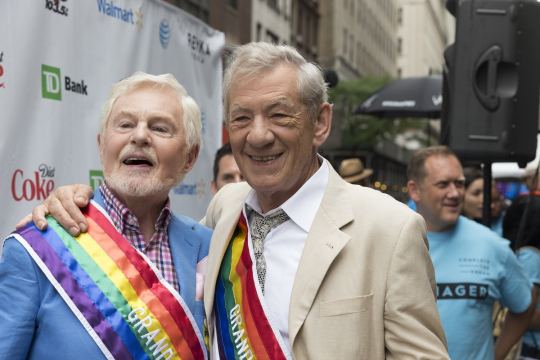
Jacobi and McKellen as grand marshals of New York City's 2015 pride march.
All Good Omens (show) fans will know Derek Jacobi as the Metatron. His brief role on Doctor Who is also getting a lot of mention in recent posts, but I'm not going to talk about any of that.
Like his Vicious co-star Ian McKellen, Jacobi has had a long and illustrious career in theatre, television, and film. McKellen and Jacobi met when they were at Cambridge.
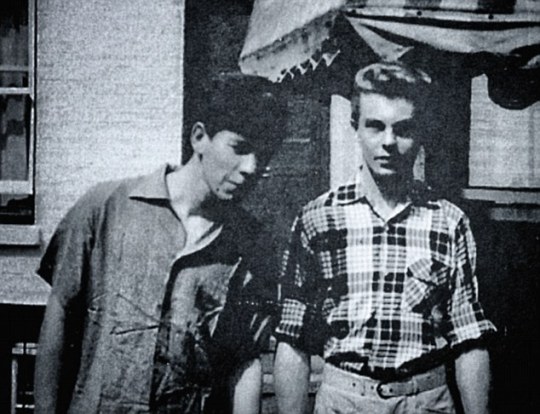
I'm not a huge fan of the Daily Mail, but this article, an interview with the two actors, is quite interesting. I'll just quote this part:
Jacobi says he came out to his mother when he was at university. ‘She said, “All young men, go through this phase, don’t worry.” I remember saying, “Don’t tell Dad.”’ He doesn’t know to this day if she did. ‘I think she did, but I don’t know. But they were wonderful, my parents, not much was said but they kind of knew, they got it.’
McKellen hasn’t heard his friend talk of this before. ‘That’s the first time I’ve heard that,’ he says, genuinely moved. ‘I never came out to my family. Biggest regret of my life.’ It turns out he didn’t even come out to Derek at university, even though it’s always been reported that he had something of a crush on him.
‘Yes, I did fancy Derek, but I didn’t act on it, God, no. It was illegal, remember. I do get on my high horse about it, because it was so difficult. There were no gay clubs you could go to. No gay bars, no gay newspaper, nothing. What there was was a bit sleazy, I suspect. One of the reasons I became an actor was that you could meet gay people. Even then everything was difficult. When you went to America they asked, “Are you now, or have you ever been, homosexual?” I lied on the form. It was a different world.’
I want to talk about Vicious for a bit, the ITV britcom in which Derek Jacobi and Ian McKellen play an aging gay couple, (respectively) a homemaker, Stuart Bixby, and an actor, Freddie Thornhill, for fourteen episodes.
Freddie (McKellen) tells Stuart (Jacobi) about a part he's hoping to get.
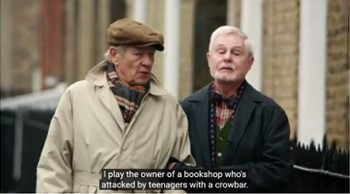
I had to add these for the Broadchurch reference.
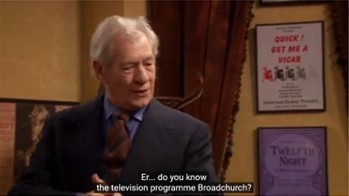
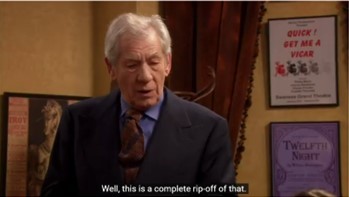
It's a law that British actors of a certain age play this part.
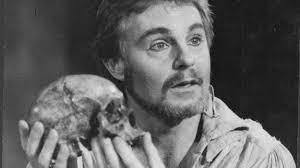
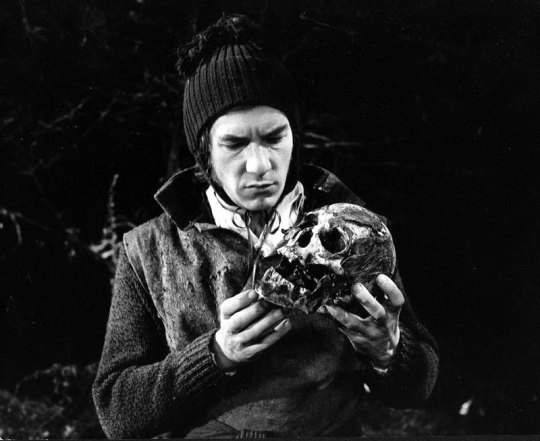

I couldn't find one with Michael Sheen and the skull, but here he is in the role.
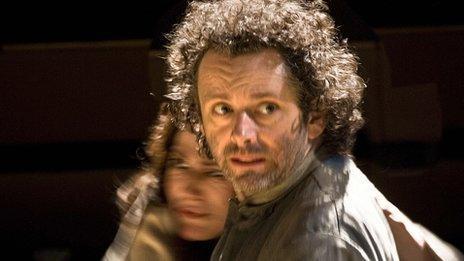
McKellen did the part again at 81 in an age-blind production.
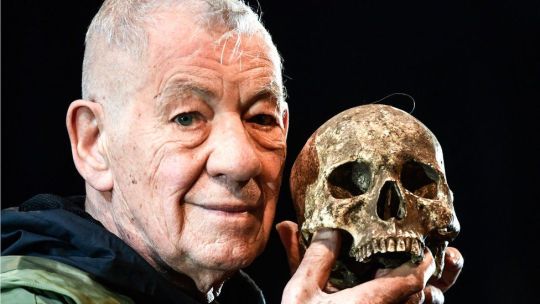
Jacobi's big breakout was the titular role in I, Claudius on the BBC in 1976.
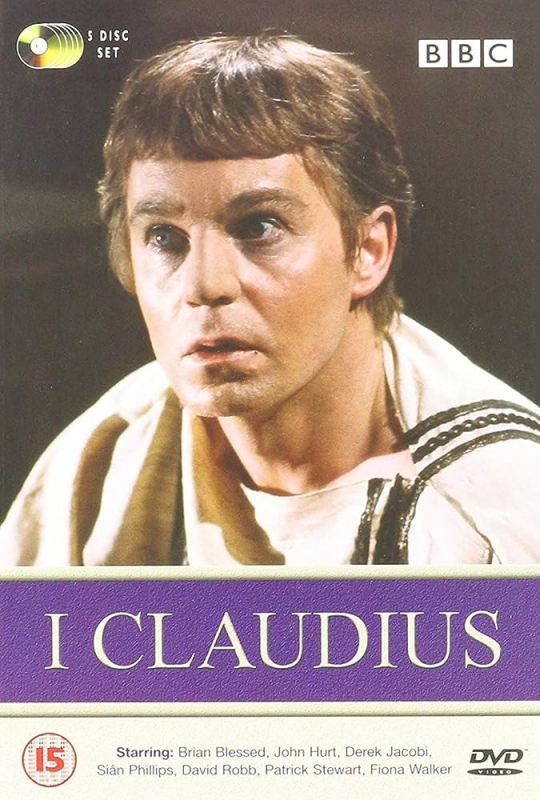
In the '90s, Jacobi played amateur sleuth and 12th century monk, Brother Cadfael on the ITV series.
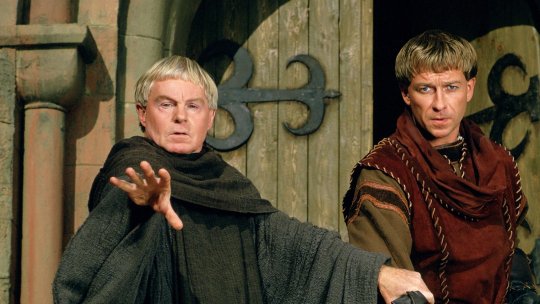
I had watched some of Vicious before, but, spurred on by Jacobi's reappearance on Good Omens, looked for it again and watched both seasons a couple of weeks ago. Because I love a good fancast and Jacobi and Sheen (at least as Aziraphale) remind me a little of each other, I couldn't help but think that Jacobi and McKellen in their youth could have played a version of Aziraphale and Crowley. (There have been a couple of posts noting this about Jacobi, and that he might have been up for the part if it had been done soon after the book came out.)


Jacobi, left, and McKellen, right (obviously).
I also think that Tennant and Sheen could have pulled off playing Freddie and Stuart in a flashback.
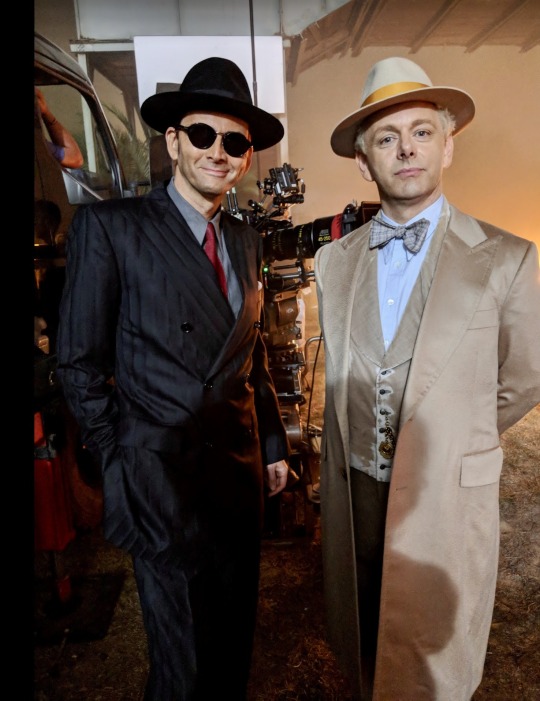
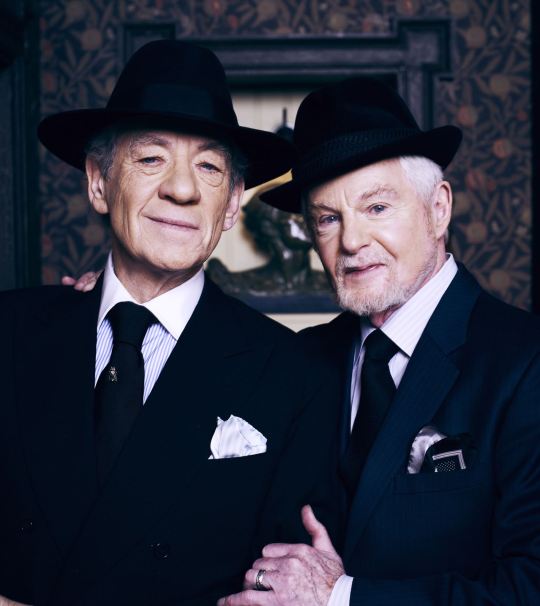
An even younger version of Freddie and Stuart does appear in the series, however, played by Luke Treadaway and Samuel Barnett.
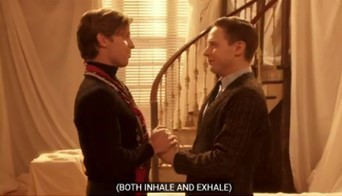
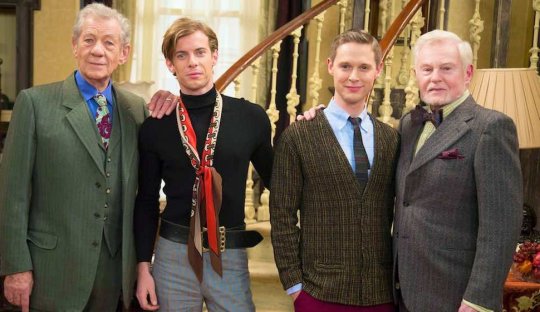
Also good casting! They do a great job playing McKellen and Jacobi playing Freddie and Stuart.
Shoutout to this post by @ember-knights, that suggested Good Omens fans should check out Vicious for a glimpse of what life in the South Downs cottage might be. And also to other posts mentioning Vicious and Good Omens in the same breath, as well as comparing Sheen and Tennant to Jacobi and McKellen (which I probably reblogged but can't find right now).
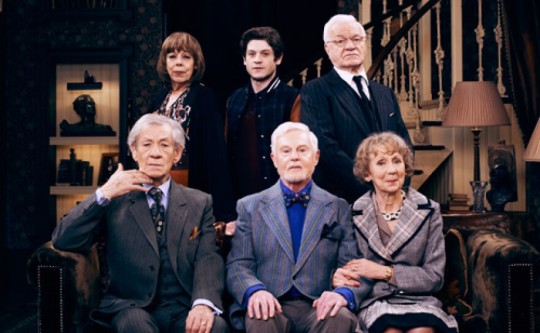
Cast of Vicious: Frances de la Tour, Iwan Rheon, Philip Voss, Ian McKellen, Derek Jacobi, Marcia Warren (Wikipedia). (Yes, the upstairs neighbor (Rheon) does go on to play Ramsay Bolton on Game of Thrones. He's a sweetheart in this, though.)
Now, I don't think Crowley and Aziraphale are the same as Freddie and Stuart, by any means. Freddie and Stuart say quite cruel things to each other. The characters become deeper in the second season; it’s a little sweeter than the first. I enjoy the bitterness of the first season too, though. It is funny, and Good Omens fans may enjoy watching it if only to see Derek Jacobi (who plays the Metatron) in a comedy role and a role that's sympathetic, especially if they are not familiar with his large and impressive body of work.
I don't think Aziraphale and Crowley's life in the bookshop as a couple, not just a group of two, or life on the South Downs, would be exactly like this, but there are somehow some similarities that I don't even know how to begin to pinpoint or explicate.
Crowley and Aziraphale’s affection is always so palpable and that’s not always clear with Freddie and Stuart. Crowley and Aziraphale are so loving that, even when they're bickering, it's joyful, even when they're arguing, even when they're coming apart (temporarily) at the seams, their love is undeniable. I don’t even think their breakup was toxic; although they were desperate at that point and hurt each other badly, it wasn't what they wanted. Sometimes it's that way.
And, lest I'm putting you off Vicious here, the Ineffable Husbands are a high bar as love stories go, but you will get to see some love and affection between Freddie and Stuart too, and I'd really love to see these actors work together more. (I am happy with how the show ends up, by the way.)
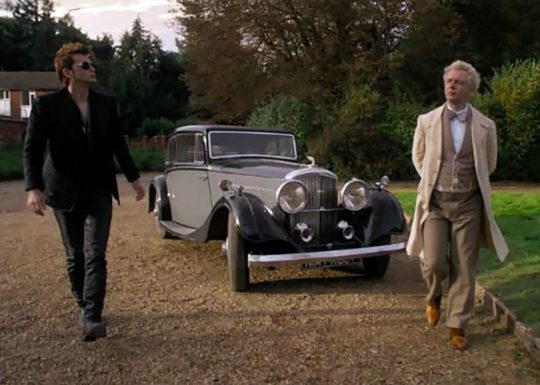
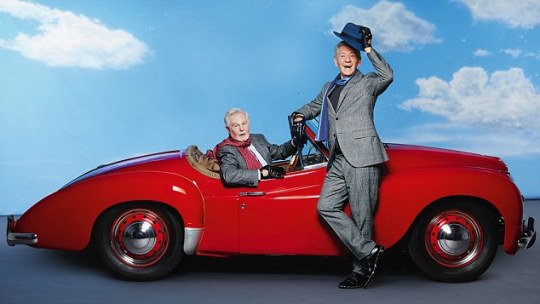
Toodle-loo! Hope everything is tickety-boo with you.
#Good Omens spoilers#Good Omens#Good Omens viewpoints#Derek Jacobi#Ian McKellen#Vicious#Derek Jacobi appreciation post#***Good Omens#tickety boo
504 notes
·
View notes
Text
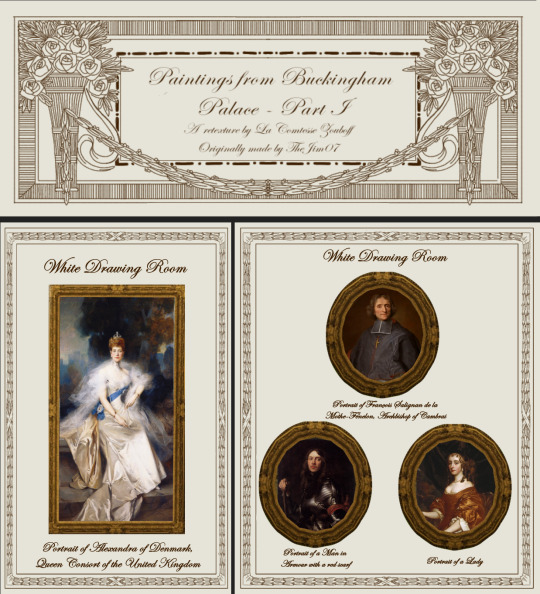
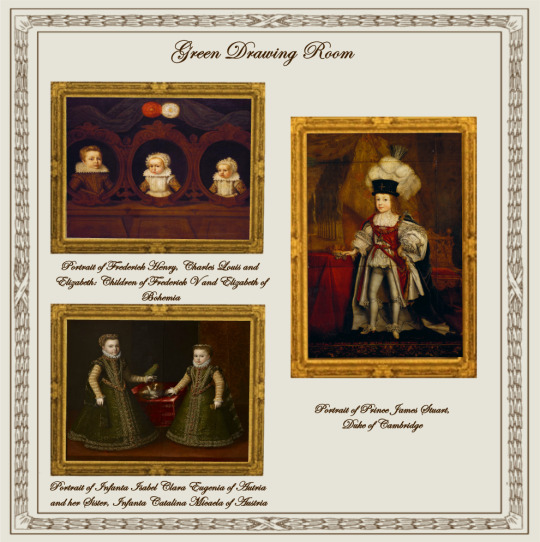
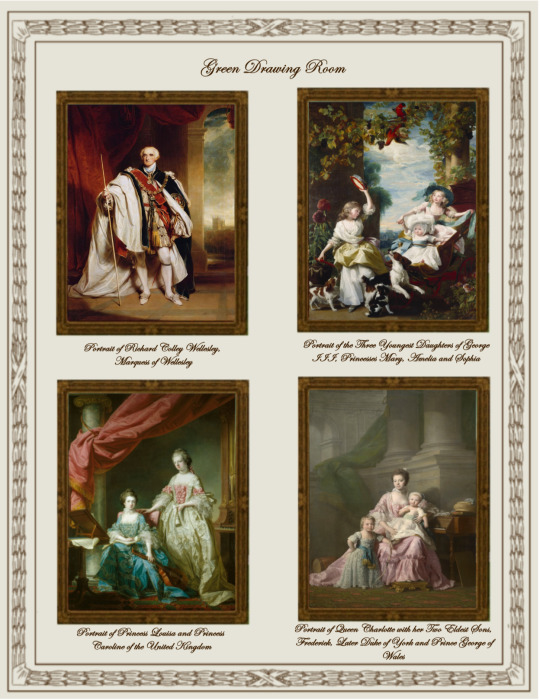
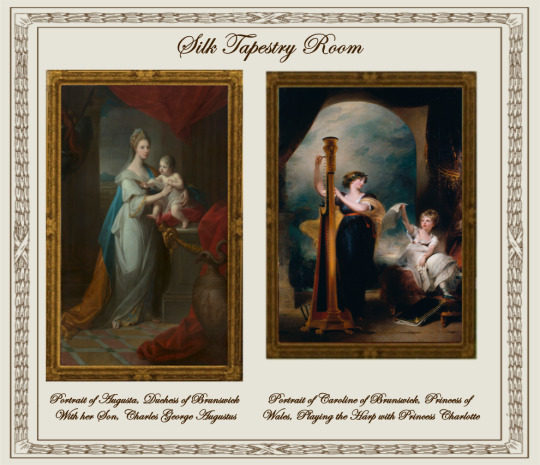

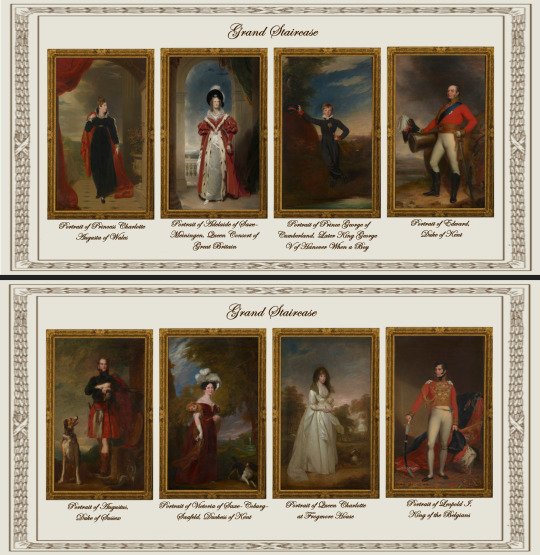
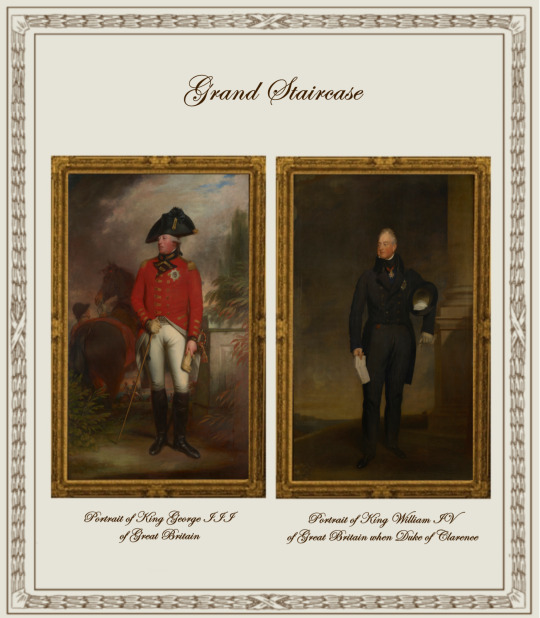
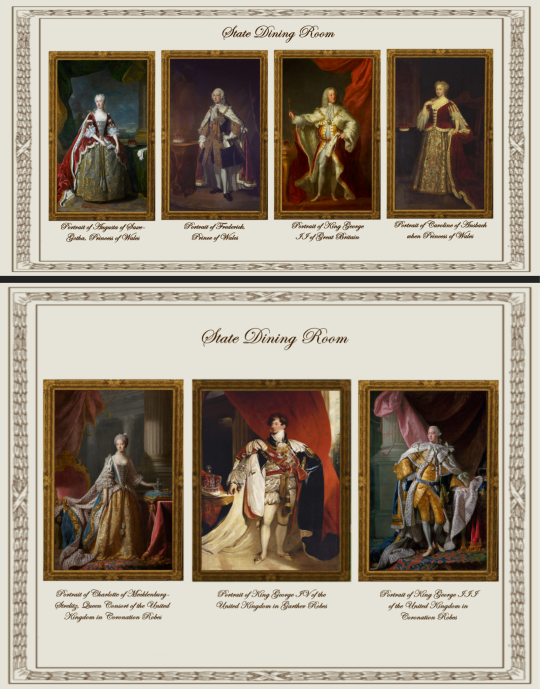
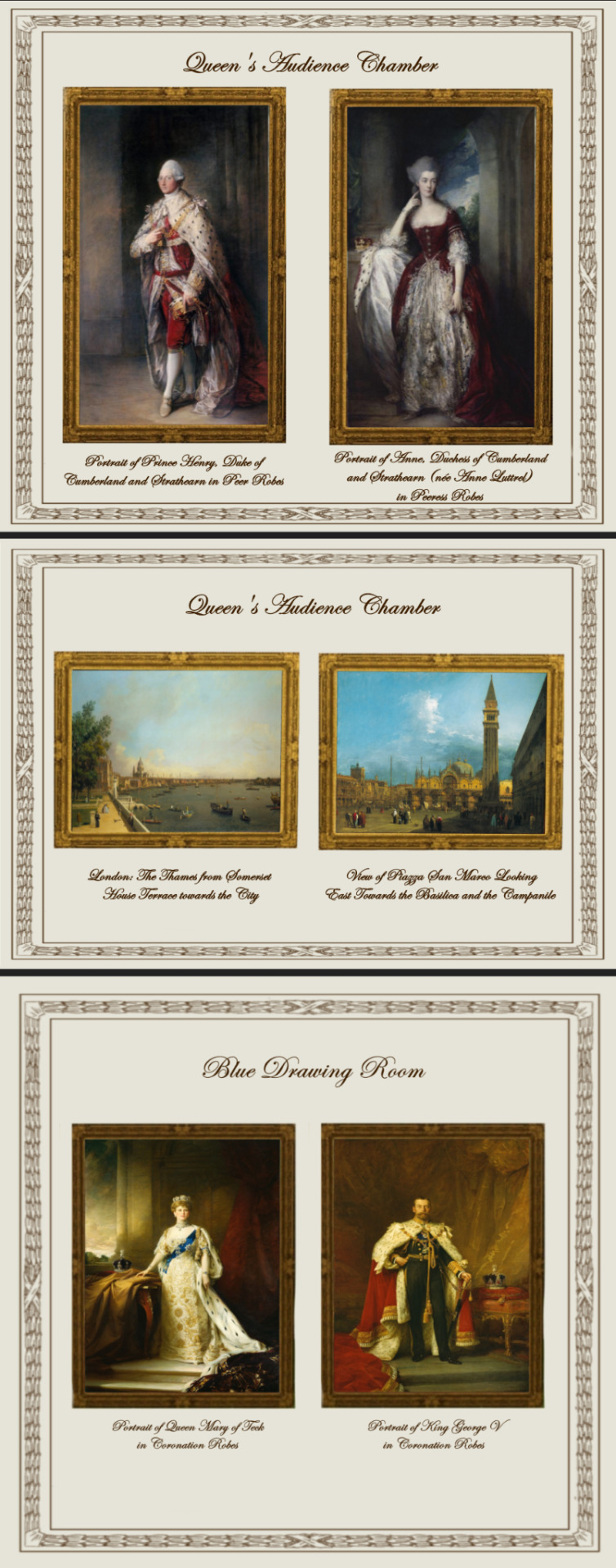
Paintings from Buckingham Palace: part I
A retexture by La Comtesse Zouboff — Original Mesh by @thejim07
100 followers gift!
First of all, I would like to thank you all for this amazing year! It's been a pleasure meeting you all and I'm beyond thankful for your support.
Spread among 13 occupied and historic royal residences in the United Kingdom, the collection is owned by King Charles III and overseen by the Royal Collection Trust. The British monarch owns some of the collection in right of the Crown and some as a private individual. It is made up of over one million objects, including 7,000 paintings, over 150,000 works on paper, this including 30,000 watercolours and drawings, and about 450,000 photographs, as well as around 700,000 works of art, including tapestries, furniture, ceramics, textiles, carriages, weapons, armour, jewellery, clocks, musical instruments, tableware, plants, manuscripts, books, and sculptures.
Some of the buildings which house the collection, such as Hampton Court Palace, are open to the public and not lived in by the Royal Family, whilst others, such as Windsor Castle, Kensington Palace and the most remarkable of them, Buckingham Palace are both residences and open to the public.
About 3,000 objects are on loan to museums throughout the world, and many others are lent on a temporary basis to exhibitions.
-------------------------------------------------------
This first part includes the paintings displayed in the White Drawing Room, the Green Drawing Room, the Silk Tapestry Room, the Guard Chamber, the Grand Staircase, the State Dining Room, the Queen's Audience Room and the Blue Drawing Room,
This set contains 37 paintings and tapestries with the original frame swatches, fully recolourable. They are:
White Drawing Room (WDR):
Portrait of François Salignan de la Mothe-Fénelon, Archbishop of Cambrai (Joseph Vivien)
Portrait of a Lady (Sir Peter Lely)
Portrait of a Man in Armour with a red scarf (Anthony van Dyck)
Portrait of Alexandra of Denmark, Queen Consort of the United Kingdom and Empress of India (François Flameng)
Green Drawing Room (GDR):
Portrait of Prince James Stuart, Duke of Cambridge (John Michael Wright)
Portrait of Frederick Henry, Charles Louis and Elizabeth: Children of Frederick V and Elizabeth of Bohemia (unknown)
Portrait of Infanta Isabel Clara Eugenia of Autria and her Sister, Infanta Catalina Micaela of Austria (Alonso Sanchez Coello)
Portrait of Princess Louisa and Princess Caroline of the United Kingdom (Francis Cotes)
Portrait of Queen Charlotte with her Two Eldest Sons, Frederick, Later Duke of York and Prince George of Wales (Allan Ramsay)
Portrait of Richard Colley Wellesley, Marquess of Wellesley (Martin Archer Shee)
Portrait of the Three Youngest Daughters of George III, Princesses Mary, Amelia and Sophia (John Singleton Copley)
Silk Tapestry Room (STR):
Portrait of Caroline of Brunswick, Princess of Wales, Playing the Harp with Princess Charlotte (Sir Thomas Lawrence)
Portrait of Augusta, Duchess of Brunswick With her Son, Charles George Augustus (Angelica Kauffmann)
Guard Chamber (GC):
Les Portières des Dieux: Bacchus (Manufacture Royale des Gobelins)
Les Portières des Dieux: Venus (Manufacture Royale des Gobelins)
Les Portières des Dieux (Manufacture Royale des Gobelins)
Grand Staircarse (GS):
Portrait of Adelaide of Saxe-Meiningen, Queen Consort of Great Britain (Martin Archer Shee)
Portrait of Augustus, Duke of Sussex (Sir David Wilkie)
Portrait of Edward, Duke of Kent (George Dawe)
Portrait of King George III of Great Britain (Sir William Beechey)
Portrait of King William IV of Great Britain when Duke of Clarence (Sir Thomas Lawrence)
Portrait of Leopold I, King of the Belgians (William Corden the Younger)
Portrait of Prince George of Cumberland, Later King George V of Hanover When a Boy (Sir Thomas Lawrence)
Portrait of Princess Charlotte Augusta of Wales (George Dawe)
Portrait of Queen Charlotte at Frogmore House (Sir William Beechey)
Portrait of Victoria of Saxe-Coburg-Saafeld, Duchess of Kent (Sir George Hayter)
State Dining Room (SDR):
Portrait of Charlotte of Mecklenburg-Strelitz, Queen Consort of the United Kingdom in Coronation Robes (Allan Ramsay)
Portrait of King George III of the United Kingdom in Coronation Robes (Allan Ramsay)
Portrait of Augusta of Saxe-Gotha, Princess of Wales (Jean-Baptiste Van Loo)
Portrait of Caroline of Ansbach when Princess of Wales (Sir Godfrey Kneller)
Portrait of Frederick, Princes of Wales (Jean-Baptiste Van Loo)
Portrait of King George II of Great Britain (John Shackleton)
Portrait of King George IV of the United Kingdom in Garther Robes (Sir Thomas Lawrence)
Queen's Audience Room (QAR):
Portrait of Anne, Duchess of Cumberland and Strathearn (née Anne Luttrel) in Peeress Robes (Sir Thomas Gainsborough)
Portrait of Prince Henry, Duke of Cumberland and Strathearn in Peer Robes (Sir Thomas Gainsborough)
London: The Thames from Somerset House Terrace towards the City (Giovanni Antonio Canal "Canaletto")
View of Piazza San Marco Looking East Towards the Basilica and the Campanile (Giovanni Antonio Canal "Canaletto")
Blue Drawing Room (BDR)
Portrait of King George V in Coronation Robes (Sir Samuel Luke Fildes)
Portrait of Queen Mary of Teck in Coronation Robes (Sir William Samuel Henry Llewellyn)
-------------------------------------------------------
Found under decor > paintings for:
500§ (WDR: 1,2 & 3)
1850§ (GDR: 1)
1960§ (GDR: 2 & 3 |QAR 3 & 4)
3040§ (STR, 1 |GC: 1 & 2|SDR: 1 & 2)
3050§ (GC:1 |GS: all 10|WDR: 4 |SDR: 3,4,5 & 6)
3560§ (QAR: 1 & 2|STR: 2)
3900§ (SDR: 7| BDR: 1 & 2|GDR: 4,5,6 & 7)
Retextured from:
"Saint Mary Magdalene" (WDR: 1,2 & 3) found here .
"The virgin of the Rosary" (GDR: 1) found here .
"The Four Cardinal Virtues" (GDR: 2&3|QAR 3 & 4) found here.
"Mariana of Austria in Prayer" (STR, 1, GC: 1 & 2|SDR: 1 & 2) found here.
"Portrait of Philip IV with a lion at his feet" (GC:1 |GS: all 10|WDR: 4 |SDR: 3,4,5 & 6) found here
"Length Portrait of Mrs.D" (QAR: 1 & 2|STR: 2) found here
"Portrait of Maria Theresa of Austria and her Son, le Grand Dauphin" (SDR: 7| BDR: 1 & 2|GDR: 4,5,6 & 7) found here
(you can just search for "Buckingham Palace" using the catalog search mod to find the entire set much easier!)
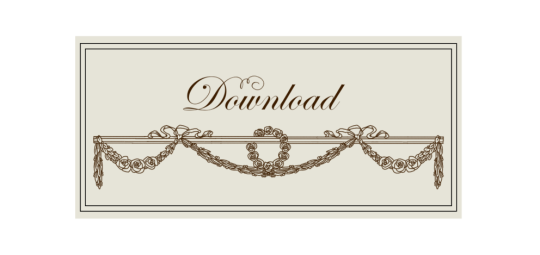
Drive
(Sims3pack | Package)
(Useful tags below)
@joojconverts @ts3history @ts3historicalccfinds @deniisu-sims @katsujiiccfinds @gifappels-stuff
-------------------------------------------------------
#the sims 3#ts3#s3cc#sims 3#sims 3 cc#sims 3 download#sims 3 decor#edwardian#rococo#baroque#renaissance#buckingham#buckingham palace#royal collection trust#wall decor
126 notes
·
View notes
Text



On August 10, 1784 artist, Allan Ramsay Jnr died.
Son of Allan Ramsay the poet, he was born in Edinburgh and went to London and Rome to study art. Returning to Edinburgh he undertook a number of portrait commissions and became an established artist.
He moved to London and soon had a wide number of distinguished clients, including George III, Flora Macdonald , David Hume, Gibbon and Rousseau - but the latter did not like the result!
He is said to have led the way in a more relaxed style of presenting the subject of the portrait, instead of the previous more formal approach. Ramsay was a part of the intellectual society of the day and was a friend of Dr Johnson. As the leading portrait painter of the day, he amassed a large fortune and spent some time in Italy before retiring to Dover where he died on August 10, 1784. The National Portrait Galleries in both London and Edinburgh have examples of his work.
His father is arguably more famous than our Allan here, possibly the best monument to his son is the fact that earlier this year, his long lost portrait of Charles Edward Stuart, painted at Holyrood in 1745, was bought for the nation at a cost of more than £1 million and is in the Scottish National Portrait Gallery.
Ramsay Garden in Edinburgh, at the top of the High Street near the Castle, was built on the site of the Ramsay family home and was named after the father and son.
I think it's only fitting that his portrait of Flora Macdonald sit beside that of the prince in this post, along with a self-portrait.
15 notes
·
View notes
Note
I don’t know if you answered this question but can you give me a full run down of King James’s back story? I wanna know all the good and bad shit that’s happened to him because he seems interesting 😭
Yes, I already did a post like that, here, but basically here we are:
9th march 1566, queen Mary’s secretary, the Italian Davide Rizzio ( or Riccio ) was stabbed 57 times by plotters, he tried to save himself hiding behind the queen but it doesn’t work.
Mary was deeply traumatized for this not only per sè but for an other motive. She was six moth pregnant and lord Ruthven pointed his sword against her belly and threated to cut her “in pieces”. Yes, James was not even born, it was said that he was afraid of swords ‘cause this.
when he was 8 months his father was killed, by the man who became his stepfather, his mother was innocent
The 24 april 1567 he saw for the last time his mother, queen Mary Stuart was abducted, imprisoned and raped by James Hepbun lord Bothwell. Yes, I know, for someone Mary/Bothwell is a very romantic love story but let’s be clear: it was a toxic relationship
Two moths later his mother was forced to marry Bothwell 'cause she’s pregnant, with twins, and after a short civil war she’s imprisoned by the queen Elizabeth
James was crowned king at 13 months and the regency was on his half uncle, lord James Moray
James Moray was killed in 1570
The the regent become the king’s granfather: Matthew Lennox
Matthew Lennox was killed when James was 5, and it’s very gory: the consipirator stabbed him in front of the child, Lennox tried to save himself behind his king, and grandchild but he was taken away by force, then his body, baraly alive, was take near a window and throw away…. ALL OF THIS in front a 5 year child
James was physically abused by his tutor George Buchanan, a puritan fanatic who hates monarchy and beaten his pupil nearly every day. James will be one of the most cultured king but he the trauma never left him, one day when he was already king of England he met an old man who looks like Buchanan and he started to tremble.
He said about his tutor “I learned Latin before English”, Buchanan also lied about queen Mary’s involment in the Darley’s death
when he was 13 he met his father’s cousin, Esmé Stuart and he fall in love with him. Esmé was 39, he’s catholic and French so after one year he was forced to exil but he helped James to start to debunk some things about his mother
when he was 14 he was abucted for an year and nearly killed
when he was 15 he executed the last noble who was involved in his father's death
he never did anything for his mother, he and Elizabeth Tudor agreed on a deal: they prefered a prison mary than a free Mary, but a dead Mary was the best. was he an horrible son? No, he barely remember his mother, he was brainwashed and he understood how her death could be an improvment for his cause. Was it a trauma? Ni
In 1600 the Ruthven brothers tried to kidnap the king but they were discovered and killed. BONUS: it's an honey trap and the man who killed the young and fair Alexander Ruthven was John Ramsay, then Earl of Holderness, the king's favourite at times
So, when he become king of England in 1603 James was a depply traumatized man and a very paranoic king who never trust his new subjets
10 notes
·
View notes
Note
wait whatt???? tuggoffelees kiss????? i need context! what production, is there a link to the (bad quality, i know) video, tell me everything you know! :O please<3
I HAVE MORE INFO!!! Because I for once decided to actually read the description
Mistoffelees is played by Guy Paul Roult and Tugger is maybe played by Stuart Ramsay (there's a ? after his name so idk). These legends behind the pixles, I bow down to you... Also the production was the third UK tour in 2003!

#cats the musical#mr mistoffelees#rum tum tugger#tuggoffelees#answered asks#my post#I have another post with the link :*
21 notes
·
View notes
Text
About the Mun!
Name/Ailias: Jess. On twitch I go by Diehards or FT. I also respond to J.
Age: 31, older than dirt.
Favorite season: Fall and winter for sure. Seasonal depression is a thing, but I love cold weather. Die, bugs.
Favorite book?: The Martian! It's sooooo good.
Favorite color: blue and green.
Scars/stories behind them?: one on my eyebrow from smashing my head as a baby. Two on my left forearm because I jumped stupidly in the middle of a dog fight to save my dog and got bit bad enough to need to be rushed to the hospital. I don't regret it. My dog is alive and well.
Pets?: 3 dogs, 5 cats, 3 mice. Got me a zoo here. I used to own a reptile rescue and had snakes and beardies up the wall, but I stopped that when I moved.
Hobbies: Writing. I stream games on twitch. Binging shows with Gordon Ramsay lmao.
Partner?: Yes. His name is Stuart and he lives in Scotland (im US). He comes for month long visits 2-3 times a year. He just left recently actually and I miss him terribly.
Kids?: Not yet. Stu has to get his citizenship here first. I do have a baby niece that I'm obsessed with though.
Special talents?: getting myself into messes, sleeping, I'm pretty good with dogs and cats (I used to do rescue and fostering).
Tag people you'd like to know better: @wildxplosion @iamgroundzero @invisiquirk @redriotkiri @ericense @spezialistin @jinnorei @punkedhero @pollicitatus @ghoulsmuses @duoplicitous @crmtn @roguesenses @portraitsof @burdenedreverance @hissuccessor @explodcor @fiercelywinged @houkusu @valorheroics @distortedbeat @vsagis
15 notes
·
View notes
Text
Commons Vote
On: Opposition day: Winter Fuel Payment
Ayes: 214 (51.6% Con, 32.4% LD, 4.2% SNP, 2.3% Ind, 2.3% DUP, 1.9% PC, 1.9% RUK, 1.9% Green, 0.5% APNI, 0.5% UUP, 0.5% TUV) Noes: 335 (99.7% Lab, 0.3% Ind) Absent: ~101
Day's business papers: 2024-09-10
Individual Votes:
Ayes
Conservative (110 votes)
Alan Mak Alberto Costa Alec Shelbrooke Alex Burghart Alicia Kearns Alison Griffiths Andrew Bowie Andrew Griffith Andrew Mitchell Andrew Murrison Andrew Snowden Aphra Brandreth Ashley Fox Ben Obese-Jecty Ben Spencer Bernard Jenkin Blake Stephenson Bob Blackman Bradley Thomas Caroline Dinenage Caroline Johnson Charlie Dewhirst Chris Philp Christopher Chope Claire Coutinho Damian Hinds Danny Kruger David Davis David Mundell David Reed David Simmonds Desmond Swayne Edward Argar Edward Leigh Gagan Mohindra Gareth Bacon Gavin Williamson Geoffrey Clifton-Brown George Freeman Graham Stuart Greg Smith Gregory Stafford Harriet Cross Harriett Baldwin Helen Grant Helen Whately Iain Duncan Smith Jack Rankin James Cartlidge James Cleverly James Wild Jeremy Hunt Jeremy Wright Jerome Mayhew Jesse Norman Joe Robertson John Cooper John Glen John Hayes John Lamont John Whittingdale Joy Morrissey Julia Lopez Julian Lewis Karen Bradley Katie Lam Kemi Badenoch Kevin Hollinrake Kieran Mullan Kit Malthouse Laura Trott Lewis Cocking Lincoln Jopp Luke Evans Mark Francois Mark Garnier Matt Vickers Mel Stride Mike Wood Mims Davies Neil Hudson Neil O'Brien Neil Shastri-Hurst Nick Timothy Nigel Huddleston Oliver Dowden Patrick Spencer Paul Holmes Peter Bedford Peter Fortune Priti Patel Rebecca Paul Rebecca Smith Richard Fuller Richard Holden Rishi Sunak Robbie Moore Robert Jenrick Roger Gale Saqib Bhatti Sarah Bool Shivani Raja Simon Hoare Steve Barclay Stuart Anderson Stuart Andrew Suella Braverman Tom Tugendhat Victoria Atkins Wendy Morton
Liberal Democrat (69 votes)
Adam Dance Al Pinkerton Alex Brewer Alison Bennett Alistair Carmichael Andrew George Angus MacDonald Anna Sabine Ben Maguire Bobby Dean Brian Mathew Calum Miller Cameron Thomas Caroline Voaden Charlie Maynard Charlotte Cane Chris Coghlan Christine Jardine Claire Young Clive Jones Daisy Cooper Danny Chambers David Chadwick Ed Davey Edward Morello Freddie van Mierlo Gideon Amos Helen Maguire Helen Morgan Ian Roome Ian Sollom James MacCleary Jamie Stone Jess Brown-Fuller John Milne Josh Babarinde Joshua Reynolds Layla Moran Lee Dillon Lisa Smart Liz Jarvis Luke Taylor Manuela Perteghella Marie Goldman Martin Wrigley Max Wilkinson Mike Martin Monica Harding Munira Wilson Olly Glover Paul Kohler Pippa Heylings Rachel Gilmour Richard Foord Roz Savage Sarah Dyke Sarah Gibson Sarah Green Sarah Olney Steff Aquarone Susan Murray Tessa Munt Tom Gordon Tom Morrison Victoria Collins Vikki Slade Wera Hobhouse Will Forster Zöe Franklin
Scottish National Party (9 votes)
Brendan O'Hara Chris Law Dave Doogan Graham Leadbitter Kirsty Blackman Pete Wishart Seamus Logan Stephen Flynn Stephen Gethins
Independent (5 votes)
Adnan Hussain Ayoub Khan Iqbal Mohamed Jeremy Corbyn Shockat Adam
Democratic Unionist Party (5 votes)
Carla Lockhart Gavin Robinson Gregory Campbell Jim Shannon Sammy Wilson
Plaid Cymru (4 votes)
Ann Davies Ben Lake Liz Saville Roberts Llinos Medi
Reform UK (4 votes)
James McMurdock Lee Anderson Richard Tice Rupert Lowe
Green Party (4 votes)
Adrian Ramsay Carla Denyer Ellie Chowns Siân Berry
Alliance (1 vote)
Sorcha Eastwood
Ulster Unionist Party (1 vote)
Robin Swann
Traditional Unionist Voice (1 vote)
Jim Allister
Noes
Labour (335 votes)
Abena Oppong-Asare Adam Jogee Adam Thompson Afzal Khan Al Carns Alan Campbell Alan Gemmell Alan Strickland Alex Baker Alex Ballinger Alex Barros-Curtis Alex Davies-Jones Alex Mayer Alex McIntyre Alex Norris Alex Sobel Alice Macdonald Alison Hume Alison Taylor Alistair Strathern Allison Gardner Amanda Hack Andrew Cooper Andrew Gwynne Andrew Lewin Andrew Pakes Andrew Ranger Andrew Western Andy MacNae Andy Slaughter Angela Eagle Angela Rayner Anna Dixon Anna Gelderd Anna Turley Anneliese Dodds Anneliese Midgley Antonia Bance Ashley Dalton Baggy Shanker Bambos Charalambous Barry Gardiner Becky Gittins Ben Coleman Ben Goldsborough Bill Esterson Blair McDougall Brian Leishman Bridget Phillipson Callum Anderson Calvin Bailey Carolyn Harris Catherine Atkinson Catherine Fookes Catherine McKinnell Catherine West Charlotte Nichols Chi Onwurah Chris Bloore Chris Bryant Chris Curtis Chris Elmore Chris Evans Chris Hinchliff Chris Kane Chris McDonald Chris Murray Chris Vince Chris Ward Claire Hazelgrove Claire Hughes Clive Betts Connor Naismith Connor Rand Damien Egan Dan Aldridge Dan Carden Dan Jarvis Dan Norris Dan Tomlinson Daniel Francis Danny Beales Darren Jones Darren Paffey Dave Robertson David Baines David Burton-Sampson David Pinto-Duschinsky David Smith David Taylor David Williams Debbie Abrahams Deirdre Costigan Derek Twigg Douglas Alexander Douglas McAllister Ed Miliband Elaine Stewart Ellie Reeves Emily Darlington Emily Thornberry Emma Foody Emma Hardy Emma Reynolds Fabian Hamilton Feryal Clark Florence Eshalomi Frank McNally Fred Thomas Gareth Snell Gareth Thomas Georgia Gould Gerald Jones Gill German Gordon McKee Graeme Downie Graham Stringer Gregor Poynton Gurinder Singh Josan Hamish Falconer Harpreet Uppal Heidi Alexander Helen Hayes Helena Dollimore Henry Tufnell Ian Murray Imogen Walker Irene Campbell Jack Abbott Jacob Collier Jade Botterill Jake Richards James Asser James Frith James Murray James Naish Janet Daby Jas Athwal Jayne Kirkham Jeevun Sandher Jeff Smith Jen Craft Jess Asato Jessica Morden Jessica Toale Jim Dickson Jim McMahon Jo Platt Jo Stevens Jo White Joani Reid Jodie Gosling Joe Morris Joe Powell Johanna Baxter John Grady John Slinger John Whitby Jon Pearce Jonathan Brash Jonathan Davies Jonathan Hinder Jonathan Reynolds Josh Dean Josh MacAlister Josh Newbury Josh Simons Julie Minns Juliet Campbell Justin Madders Kanishka Narayan Karin Smyth Karl Turner Kate Dearden Katie White Katrina Murray Keir Mather Kerry McCarthy Kevin Bonavia Kevin McKenna Kim Leadbeater Kirith Entwistle Kirsteen Sullivan Kirsty McNeill Laura Kyrke-Smith Lauren Edwards Lauren Sullivan Laurence Turner Lee Barron Lee Pitcher Lewis Atkinson Liam Byrne Liam Conlon Lilian Greenwood Lillian Jones Linsey Farnsworth Lisa Nandy Liz Kendall Liz Twist Lizzi Collinge Lloyd Hatton Lola McEvoy Louise Haigh Louise Jones Lucy Powell Lucy Rigby Luke Akehurst Luke Charters Luke Murphy Luke Myer Luke Pollard Margaret Mullane Marie Tidball Mark Ferguson Mark Hendrick Mark Sewards Mark Tami Markus Campbell-Savours Martin McCluskey Martin Rhodes Mary Creagh Mary Glindon Matt Rodda Matt Turmaine Matt Western Matthew Patrick Matthew Pennycook Maureen Burke Maya Ellis Meg Hillier Melanie Onn Melanie Ward Michael Payne Michael Shanks Michael Wheeler Michelle Scrogham Michelle Welsh Mike Amesbury Mike Kane Mike Reader Mike Tapp Natalie Fleet Natasha Irons Navendu Mishra Neil Coyle Nesil Caliskan Nia Griffith Nicholas Dakin Nick Smith Noah Law Oliver Ryan Olivia Bailey Olivia Blake Pam Cox Pamela Nash Pat McFadden Patricia Ferguson Patrick Hurley Paul Davies Paul Foster Paul Waugh Perran Moon Peter Dowd Peter Kyle Peter Lamb Peter Prinsley Peter Swallow Polly Billington Preet Kaur Gill Rachel Blake Rachel Hopkins Rachel Taylor Richard Baker Richard Quigley Rosie Wrighting Rupa Huq Rushanara Ali Ruth Cadbury Ruth Jones Sadik Al-Hassan Sally Jameson Sam Carling Sam Rushworth Samantha Dixon Samantha Niblett Sarah Champion Sarah Coombes Sarah Hall Sarah Owen Sarah Russell Sarah Sackman Satvir Kaur Scott Arthur Sean Woodcock Seema Malhotra Shabana Mahmood
Shaun Davies Simon Lightwood Siobhain McDonagh Sojan Joseph Sonia Kumar Stella Creasy Stephanie Peacock Stephen Kinnock Stephen Morgan Stephen Timms Steve Race Steve Reed Steve Witherden Steve Yemm Sureena Brackenridge Taiwo Owatemi Tanmanjeet Singh Dhesi Terry Jermy Tim Roca Toby Perkins Tom Collins Tom Hayes Tom Rutland Tony Vaughan Torcuil Crichton Torsten Bell Tracy Gilbert Tristan Osborne Tulip Siddiq Uma Kumaran Valerie Vaz Vicky Foxcroft Warinder Juss Wes Streeting Will Stone Yasmin Qureshi Yuan Yang Yvette Cooper Zubir Ahmed
Independent (1 vote)
Rebecca Long Bailey
0 notes
Text
With a serial strangler on the loose, a bookkeeper wanders around town searching for the vigilante group intent on catching the killer. Credits: TheMovieDb. Film Cast: Kleinman: Woody Allen Prostitute: Kathy Bates Student Jack: John Cusack Irmy: Mia Farrow Prostitute: Jodie Foster Hacker’s Follower: Fred Gwynne Clown: John Malkovich Alma: Julie Kavner Marie: Madonna Magician: Kenneth Mars Eve: Kate Nelligan Doctor: Donald Pleasence Prostitute: Lily Tomlin Mr. Paulsen: Philip Bosco Spiro’s Assistant: Robert Joy Simon Carr: Wallace Shawn Vogel’s Follower: Kurtwood Smith Priest: Josef Sommer Hacker: David Ogden Stiers Cop at Police Station: John C. Reilly Woman with Baby: Eszter Balint Vigilante: James Rebhorn Roustabout: Richard Riehle Cop: William H. Macy Undesirables Onlooker: Fred Melamed Killer: Michael Kirby Vigilante: Victor Argo Vigilante: Daniel von Bargen Landlady: Camille Saviola Dwarf: Tim Loomis Fat Lady: Katy Dierlam Strongman: Dennis Vestunis Prostitute: Anne Lange Student: Andy Berman Student: Paul Anthony Stewart Student: Thomas L. Bolster Police Chief: Greg Stebner Cop at Police Station: Peter Appel Cop at Police Station: Brian Smiar Cop at Police Station: Michael P. Troy Cop at Police Station: Remak Ramsay Cop at Police Station: Ron Turek Bartender: Peter McRobbie Cop with Priest: Ira Wheeler Baby: Rebecca Gibson Hacker’s Follower: Robert Silver Spiro: Charles Cragin Vigilante with Spiro: Tom Riis Farrell Vigilante with Spiro: Ron Weyand Roustabout: Max Robinson Film Crew: Additional Casting: Todd M. Thaler Casting: Juliet Taylor Writer: Woody Allen Producer: Robert Greenhut Assistant Editor: Mark Livolsi Costume Design: Jeffrey Kurland Production Coordinator: Helen Robin Executive Producer: Charles H. Joffe Executive Producer: Jack Rollins Editor: Susan E. Morse Hairstylist: Romaine Greene Assistant Art Director: W. Steven Graham Casting Associate: Laura Rosenthal Supervising Sound Editor: Robert Hein Director of Photography: Carlo Di Palma Gaffer: Ray Quinlan Sound Designer: Dan Sable Foley Artist: Brian Vancho Set Decoration: George DeTitta Jr. Assistant Costume Designer: Donna Zakowska Production Sound Mixer: James Sabat Production Design: Santo Loquasto Assistant Sound Editor: Stuart Levy Co-Producer: Joseph Hartwick Sound Re-Recording Mixer: Lee Dichter Construction Coordinator: Ron Petagna Key Scenic Artist: James Sorice Production Assistant: Robert C. Albertell Makeup Artist: Bernadette Mazur First Assistant Director: Thomas A. Reilly Art Direction: Speed Hopkins Property Master: James Mazzola Assistant Production Coordinator: Ilyse A. Reutlinger Still Photographer: Brian Hamill Standby Carpenter: Joseph A. Alfieri Jr. Scenic Artist: Cosmo Sorice Set Dresser: Dave Weinman Assistant Camera: Michael Green Sound Recordist: Frank Graziadei Camera Operator: Dick Mingalone Script Supervisor: Kay Chapin Set Decoration: Amy Marshall Boom Operator: Louis Sabat Dolly Grip: Ronald Burke Key Grip: Robert Ward Wardrobe Supervisor: Patricia Eiben Second Assistant Camera: Michael Caracciolo Camera Trainee: David E. Baron Art Department Coordinator: Glenn Lloyd Second Assistant Director: Richard Patrick Assistant Editor: William Kruzykowski Transportation Captain: Peter Tavis Transportation Captain: Harold ‘Whitey’ McEvoy Production Assistant: Justin Moritt Wardrobe Supervisor: Bill Christians Foley Artist: Elisha Birnbaum Additional Casting: Judie Fixler Key Construction Grip: Vincent Guarriello Production Assistant: Danielle Rigby Projection: Carl Turnquest Best Boy Electric: Jim Manzione Costume Assistant: Lauren Gibson Assistant Art Director: Robert Perdziola Foley Editor: Lori Kornspun Assistant Art Director: Peter Eastman Location Scout: Megan Monaghan Assistant Art Director: Richard Michael Miller Apprentice Sound Editor: Yasmine Amitai Location Manager: James A. Davis Movie Reviews:
0 notes
Link
0 notes
Text
Don Quixote
• EVAN RACHEL WOOD'S DOWNBEAT TONGUE
• STUART TOWNSEND'S DOWNBEAT TONGUE
• AKSHAY KUMAR'S DOWNBEAT TONGUE
• FRANKIE DELGADO'S DOWNBEAT TONGUE
• COLTON HAYNES'S DOWNBEAT TONGUE
• NDAMUKONG SUH'S DOWNBEAT TONGUE
• ROBIN WRIGHT PENN'S DOWNBEAT TONGUE
• CHAD OCHOCINCO'S DOWNBEAT TONGUE
• NICHOLAS HOULT'S DOWNBEAT TONGUE
• MADDOX JOLIE-PITT'S DOWNBEAT TONGUE
• ELIZABETH BANKS'S DOWNBEAT TONGUE
• MIA FARROW'S DOWNBEAT TONGUE
• DAVID BECKHAM'S DOWNBEAT TONGUE
• COLIN FIRTH'S DOWNBEAT TONGUE
• ANNETTE BENING'S DOWNBEAT TONGUE
• JAVIER BARDEM'S DOWNBEAT TONGUE
• ALI FEDOTOWSKY'S DOWNBEAT TONGUE
• RICHARD GERE'S DOWNBEAT TONGUE
• PAM ANDERSON'S DOWNBEAT TONGUE
• NACHO FIGUERAS'S DOWNBEAT TONGUE
• JANELLE MONAE'S DOWNBEAT TONGUE
• ANNA NICOLE SMITH'S DOWNBEAT TONGUE
• ALEX RODRIGUEZ'S DOWNBEAT TONGUE
• MARTHA STEWART'S DOWNBEAT TONGUE
• EVA LONGORIA'S DOWNBEAT TONGUE
• JEFF PROBST'S DOWNBEAT TONGUE
• GORDON RAMSAY'S DOWNBEAT TONGUE
• HUGH JACKMAN'S DOWNBEAT TONGUE
• CAMILLE GRAMMER'S DOWNBEAT TONGUE
• GWEN STEFANI'S DOWNBEAT TONGUE
• STEPHEN DORFF'S DOWNBEAT TONGUE
• JOSH HOLLOWAY'S DOWNBEAT TONGUE
• BEYONCE KNOWLES'S DOWNBEAT TONGUE
• THE SITUATION'S DOWNBEAT TONGUE
• SOPHIE MONK'S DOWNBEAT TONGUE
• GABRIEL AUBRY'S DOWNBEAT TONGUE
• CHRISTIAN BALE'S DOWNBEAT TONGUE
• TERESA GIUDICE'S DOWNBEAT TONGUE
• LAUREN HOLLY'S DOWNBEAT TONGUE
• LEWIS HAMILTON'S DOWNBEAT TONGUE
• ALYSSA MILANO'S DOWNBEAT TONGUE
• KOURTNEY KARDASHIAN'S DOWNBEAT TONGUE
• LEVI JOHNSTON'S DOWNBEAT TONGUE
• RICK SALOMON'S DOWNBEAT TONGUE
• ISABELLA ROSSELLINI'S DOWNBEAT TONGUE
• CASH WARREN'S DOWNBEAT TONGUE
• JUSTIN THEROUX'S DOWNBEAT TONGUE
• JESSICA LOWNDES'S DOWNBEAT TONGUE
• CHLOE MORETZ'S DOWNBEAT TONGUE
0 notes
Text
Analytical Application 1: Ideology and Culturalism
Culture Industry:
youtube
Coined by Horkheimer and Adorno in "The Culture Industry: Enlightenment as Mass Deception," the term "culture industry" refers to the mass production and dissemination of cultural products within capitalist societies. This industry leads to standardized and homogenized cultural experiences that serve the interests of the ruling class, perpetuating conformity and stifling individuality. As Horkheimer and Adorno assert, "The whole world is passed through the filter of the culture industry...The result is a constant reproduction of the same thing." This suggests that the culture industry exerts a pervasive influence over all aspects of society, shaping people's experiences and perceptions while prioritizing efficiency and quantity over artistic integrity and individual expression.
The "Alexa Loses Her Voice" Amazon Super Bowl commercial epitomizes the culture industry's characteristics outlined by Horkheimer and Adorno. The commercial's polished production, featuring high-quality visuals and a meticulously scripted narrative, exemplifies the standardization and mass production inherent in the culture industry. Furthermore, the use of renowned personalities such as Gordon Ramsay and Cardi B underscores the industry's reliance on familiar figures to attract attention and generate profit.
Moreover, the commercial serves as a prime example of how the technology of the culture industry prioritizes standardization and mass production over individual expression and artistic integrity. As Horkheimer and Adorno argue, "For the present, the technology of the culture industry confines itself to standardization and mass production and sacrifices what once distinguished the logic of the work from that of society". Despite its humorous and entertaining facade, the "Alexa Loses Her Voice" commercial ultimately serves the interests of the capitalist system by promoting consumerism and reinforcing societal norms. By encouraging viewers to purchase Amazon's Alexa device as an essential commodity for modern living, the commercial perpetuates a culture of consumption while aligning with the dominant ideologies of consumer culture.
In essence, the commercial encapsulates the culture industry's pervasive influence on contemporary society, emphasizing standardization, mass production, and the prioritization of profit over artistic expression and societal critique, as illustrated by Horkheimer and Adorno's critique.
Dominant hegemonic position:
youtube
The term "dominant definitions" as articulated by Stuart Hall refers to prevailing interpretations or understandings of situations and events within society. Hall states, "The dominant definitions, however, are hegemonic precisely because they represent definitions of situations and events which are ‘in dominance.’" This quote emphasizes that these definitions hold hegemonic power because they reflect the perspectives and viewpoints of those in dominant positions of power and influence. Hall asserts that such definitions shape how situations and events are understood within society, reinforcing and legitimizing existing power structures. This concept highlights the significant role of language and discourse in shaping societal perceptions and maintaining hegemonic ideologies and social hierarchies.
In the Berlitz German Coastguard ad, the concept of the dominant hegemonic position is exemplified through the portrayal of English as the primary language for effective communication. The ad depicts the consequences of miscommunication stemming from language barriers, thereby highlighting the hegemonic status of English in global discourse. By presenting English as the preferred language for international maritime communication, the ad implicitly reinforces its dominant hegemonic position. Instead of critiquing the expectation for individuals to be proficient in English, the ad highlight its necessity in navigating professional settings. Through its comedic narrative, the ad indirectly emphasizes the practical importance of acquiring English proficiency for effective communication across diverse cultural contexts. Thus, while the ad primarily serves as a straightforward advertisement for Berlitz's English courses, it also subtly reinforces the hegemonic influence of English in contemporary society. This portrayal reflects the dominant hegemonic position of English and the pragmatic necessity of acquiring proficiency in the language.
Ideological state apparatus:
youtube
Ideological State Apparatuses (ISAs), as defined by Althusser, are a "set of distinct and specialized institutions that are immediately observable realities". These institutions, such as the media, education system, religious organizations, and cultural institutions, serve to disseminate and reinforce dominant ideologies within society. Through their specialized functions and structures, ISAs contribute to the reproduction of the relations of production and the maintenance of social order. ISAs operate by perpetuating ideologies that uphold the interests of the ruling class, thereby securing the political conditions necessary for the reproduction of existing power dynamics. By shaping individuals' perceptions, beliefs, and values, ISAs play a crucial role in sustaining the hegemony of the ruling class over subordinate groups.
Analyzing the John Lewis Christmas advert "She's Always a Woman" through the lens of Ideological State Apparatuses (ISAs) reveals how the advertisement functions as a medium for perpetuating dominant ideologies surrounding gender roles and familial expectations within society.
The portrayal of the woman's life journey aligns with prevailing ideologies upheld by ISAs, particularly those related to traditional gender roles and familial responsibilities. From childhood to adulthood, the woman is depicted in roles typically associated with femininity, such as nurturing, caregiving, and domestic duties. These representations reinforce societal norms and values surrounding women's roles as primary caregivers and homemakers, perpetuating the ideology of women as mothers and caregivers.
Furthermore, the advertisement emphasizes the importance of family and romantic relationships as central to a woman's life journey. The woman's transition from being a daughter to a wife and mother reflects the dominant ideology that prioritizes family and marriage as key milestones in a woman's life. By presenting these life events as natural and inevitable, the advertisement reinforces the hegemonic notion of women finding fulfillment through traditional familial roles.
Moreover, the ad subtly promotes consumerism by associating emotional moments and life milestones with the John Lewis brand. The use of sentimental music and imagery aims to evoke emotional responses from viewers, encouraging them to associate the brand with feelings of nostalgia, love, and family. Through this association, the advertisement reinforces the ideology of consumerism, which emphasizes the role of consumption in fulfilling emotional needs and expressing love and care for one's family.
Overall, the John Lewis Christmas advert "She's Always a Woman" functions as an Ideological State Apparatus by disseminating and perpetuating dominant ideologies related to gender roles, familial expectations, and consumer culture. Through strategic messaging and imagery, the advertisement aligns with prevailing ideologies to resonate with viewers and shape their perceptions and behaviors regarding gender, family, and consumerism.
Ruling class:
youtube
The term "ruling class" encompasses the socio-economic group wielding considerable power and influence within society, orchestrating political, economic, and social structures to serve their interests. Karl Marx and Frederick Engels, in "The Ruling Class and The Ruling Ideas," assert that "the rule of a certain class is only the rule of certain ideas." This encapsulates how the ruling class's dominance extends beyond mere economic control to shaping prevailing ideologies. The ruling class, by controlling the means of production, perpetuates its dominance through the dissemination of its ideologies. Through media, art, and cultural institutions, the ruling class instills its ideas, ensuring their perpetuation as the ruling ideas of society.
Iceland's Banned TV Christmas Advert "Say Hello to Rang-tan" implicitly critiques the actions of powerful corporations involved in palm oil production, which can be seen as representatives of the ruling class. Palm oil production, controlled by large multinational corporations, often prioritizes profit over environmental conservation, leading to widespread deforestation and ecological devastation. By highlighting the detrimental effects of this industry on the environment, the advert indirectly challenges the interests and actions of the ruling class.
Moreover, the ad's ban for being too political can be interpreted as an attempt by the ruling class or corporate interests to suppress dissenting voices and maintain their hegemonic position. This censorship underscores the power dynamics at play within society, where the ruling class seeks to control the narrative and limit opposition to its actions.
Overall, Iceland's advert serves as a form of resistance against the ruling class's exploitation of natural resources and disregard for environmental concerns. It disrupts the prevailing narrative perpetuated by dominant corporations and encourages viewers to question the actions and interests of those in power. By challenging the ruling class's control over the production and dissemination of information, the ad encourages viewers to advocate for environmental justice and hold the ruling class accountable for its actions.
Ideology:
youtube
Ideology encompasses the systems of beliefs, values, and norms that shape individuals' understanding of the world and their place within it. Ideology functions to maintain and reproduce social order by influencing perceptions, behaviors, and social interactions. It operates through various institutions such as family, education, religion, media, and government, shaping individuals' thoughts, beliefs, and actions. Ideology often serves the interests of dominant social groups and may perpetuate inequalities and power dynamics within society. Althusser's concept of ideology suggests that individuals, as consumers, embody the values and beliefs perpetuated by the industries they engage with. This notion implies that individuals are not merely passive recipients of ideology but actively participate in its reproduction through their consumption choices. As Althusser mentions, "The consumer becomes the ideology of the amusement industry, whose institutions he or she cannot escape." This perspective highlights the pervasive nature of ideology and its role in shaping individuals' experiences within consumerist societies.
"Thank You Mama" portrays the ideology of maternal love and sacrifice by depicting mothers as selfless figures who play a crucial role in nurturing and supporting their children. By celebrating the sacrifices and contributions of mothers, the advertisement reinforces societal beliefs surrounding the unconditional love and dedication of mothers.
Furthermore, the commercial promotes the ideology of family and togetherness by emphasizing the importance of maternal support in shaping the lives of children. It portrays moments of love, care, and guidance shared between mothers and their children, reinforcing the idea that family is the cornerstone of emotional well-being and personal development.
Additionally, the commercial promotes the ideology of brand loyalty by associating P&G products with moments of maternal care and nurturing. Through subtle product placements and branding, the advertisement reinforces the notion that using P&G products is not only practical but also a reflection of one's commitment to caring for their family.
Overall, P&G's "Thank You Mama – Best Job" commercial serves as a powerful vehicle for perpetuating the ideology of maternal love, family values, and brand loyalty. By aligning with these dominant cultural narratives, the advertisement resonates with viewers and reinforces broader societal norms and values surrounding motherhood, family, and consumerism.
Works cited:
Althusser, Louis. On the reproduction of capitalism: Ideology and ideological state apparatuses. Verso Books, 2014.
Hall, Stuart. "Encoding/decoding." Media studies: A reader 3 (2000): 28-38.
Horkheimer, Max and Adorno, Theodor W.. "The Culture Industry: Enlightenment as Mass Deception" In Dialectic of Enlightenment edited by Gunzelin Schmid Noeri, 94-136. Redwood City: Stanford University Press, 2002. https://doi.org/10.1515/9780804788090-007
Marx, Karl, and Friedrich Engels. "The ruling class and the ruling ideas." Media and Cultural studies (1845): 9.
@theuncannyprofessoro
0 notes
Text


October 13th 1713 saw the birth of Allan Ramsay, the Enlightenment painter.
His father was another Allan Ramsay, well known for his turban and his poetry.
He had started drawing portraits by 1729, and first trained at the Academy of St. Luke in Edinburgh before studying under Hans Hysing in London from 1732-33. Allan visited Italy from 1736-38, where he studied under Imperiali in Rome. He also drew at the French Academy there and had the distinction of being taught by Francesco Solimena in Naples. He settled in London in 1738 and soon became one of the most elegant and subtle of portrait painters. Ramsay was patronised by many of the Scottish nobility in London.
Of Ramsay's paintings that I know, my favourite is "the lost portrait of Charles Edward Stuart" a letter held in the Royal Archives tells Ramsay.........."... you are desired to come to the Palace of Holyroodhouse as soon as possible in order to take his Royal Highness’ picture. So I expect you’ll wait no further call. I am, your most humble servant, John Stuart, Holyrood House 26th of October 1745."
This never left Ramsay much time as Charlie and the Jacobite army left Edinburgh early November on their way south to Derby.
Ramsay Garden in Edinburgh, at the top of the High Street near the Castle, was built on the site of the Ramsay family home and was named after the father and son. The pics are a self portrait and Bonnie Prince Charlie.
He died at Dover on 10th August 1784. The pics are a self portrait and the lost painting of Charles Edward Stuart.
6 notes
·
View notes
Text
Analytical Application (Advertisement)
Culture Industry → Alexa
Horkheimer and Adorno describe the concept of the "culture industry” as the system where capitalist industries mass-produce cultural goods. According to them, this process standardizes and homogenizes cultural products to cater to mass consumption, resulting in formulaic content. They argued that this industrialization of culture deceives and manipulates the masses, as “the whole world is passed through the filter of the culture industry,”(1) insinuating that capitalist ideologies while stifling genuine artistic expression and critical thought.
The advertisement exemplifies the mass production and standardization of cultural products for wide consumption. Produced by Amazon, a major corporation that serves as one of the top conglomerates within the capitalist industries, the ad serves as a strategic marketing tool aimed at reaching a broad audience. Crafted to resonate with its target demographic, the ad employs humor and celebrity appearances to engage viewers and leave a lasting impression. Additionally, the ad was aired during the 2019 Super Bowl, a widely watched event that exposes millions of viewers to the company and its product. The advertisement underscores the commodification of celebrities within the culture industry. Featuring well-known personalities like Gordon Ramsay and Cardi B, the ad capitalizes on their fame to attract attention and generate interest. By using different celebrities across many different industries, they show how the Echo can essentially be involved in any aspect of life. These celebrities are transformed into commodities, used as instruments to endorse products and perpetuate consumer culture. The ad also highlights the influence of technology on contemporary cultural consumption. With smart speakers like the Echo becoming increasingly integrated into daily life, they shape how people interact with technology and consume media, and enforce the idea of an easy and good life with the help of their product. By promoting the Echo device, the advertisement reinforces the notion of technology as an indispensable component of modern living, solidifying its position within consumer culture, trying to cater towards mass consumption amongst all demographics.
youtube
Dominant Hegemonic Position → Snickers
Stuart Hall's concept of the dominant-hegemonic position depicts the prevailing stance held by powerful groups in society, influencing cultural norms, values, and media representations. This position shapes societal ideologies and practices, accommodating contradictions and conflicts with alternative interpretations. It reflects the unequal distribution of power and resources, wherein dominant groups maintain authority through the dissemination of their ideologies and control over cultural institutions, and “it serves to reproduce the dominant definitions precisely by bracketing their hegemonic quality.”(2) Hall's framework highlights the complex dynamics of power and resistance within society, illustrating how dominant ideologies are both reinforced and contested through cultural production and media discourse.
Stuart Hall's theory of the dominant-hegemonic position offers a framework for analyzing the interplay between power dynamics and cultural representations in media, exemplified by Mr. T's Snickers commercial. In the ad, Mr. T's dramatic entrance onto a soccer field in a military tank, hurling insults and a Snickers bar, embodies cultural ideals of masculinity, toughness, and charisma. This portrayal aligns with dominant cultural norms, presenting Mr. T in a humorous context that reinforces perceptions of his tough persona as the Snickers spokesperson. The commercial's slogan, "Get Some Nuts," further emphasizes this image. By showcasing Mr. T in this manner, the ad reinforces the hegemonic influence of dominant cultural figures in shaping societal narratives. Essentially, the commercial reflects the pervasive societal expectation for men to conform to a tough, masculine ideal. It perpetuates the notion that toughness and power are synonymous with masculinity, reinforcing existing gender norms. This portrayal not only reflects but also reinforces the dominant cultural discourse surrounding masculinity, highlighting the influence of powerful figures like Mr. T in shaping and perpetuating these ideals. In essence, the ad serves as a microcosm of broader societal dynamics, illustrating how dominant cultural figures reinforce and perpetuate prevailing ideologies through media representations.
youtube
Ruling Class --> German
According to Marx and Engels, the ruling class refers to the socioeconomic group that owns and controls the means of production within a capitalist society. This class, typically comprising wealthy capitalists and industrialists, holds significant power and influence over the economy, politics, and culture. They accumulate wealth and privilege through the exploitation of the labor of the working class, who are relegated to selling their labor for wages. For the ruling class, “their ideas are the ruling ideas of the epoch”(3) and they perpetuate its dominance through ownership of property, control of institutions, and shaping of societal ideologies to maintain and further their economic interests, thus perpetuating class inequality.
Marx and Engels' concept of the ruling class, which centers on the socioeconomic group that controls the means of production and wields significant power and influence within society, can be discerned in the Berlitz German Coastguard commercial, particularly through the dynamics of power and social hierarchy depicted. In the commercial, the German Coastguard officer symbolizes authority and control over maritime operations. However, when confronted with an emergency call in English, the officer's evident lack of understanding and proficiency in the language exposes a form of incompetence or disconnect from the realities faced by individuals relying on clear communication for their safety, showing how his authoritative position as inherently useless due to his lack of English fluency. The commercial's concluding message, "Improve Your English," underscores a deeper societal commentary. It suggests a narrative where the ruling class, primarily Western English-speaking societies, imposes their notion of English as the dominant language onto foreigners. This imposition serves to perpetuate English dominance and reinforces the hegemony of Western culture and values, echoing Marx and Engels' assertion of the ruling class exerting its influence to maintain control and further its interests. Furthermore, the commercial implicitly critiques the power dynamics inherent in linguistic imperialism, where dominant languages are imposed on others, often at the expense of indigenous languages and cultures. It underscores how language proficiency can be a tool of social control and exclusion, with English proficiency becoming increasingly essential for access to economic opportunities and participation in global society.
youtube
Ideology → She’s Always A Woman
Louis Althusser conceptualizes ideology as a system of beliefs and values that serves to reproduce and perpetuate existing social relations of domination and exploitation. In Althusser's framework, ideology is the system of the ideas and representations which dominate the mind of a man or a social group” (4), and operates through Ideological State Apparatuses (ISAs), such as schools, churches, media, and family, which disseminate dominant ideologies and shape individuals' subjectivities. These ideologies function to maintain the stability of capitalist societies by concealing the inherent contradictions and inequalities within them. He emphasizes the role of ideology in shaping individuals' consciousness and ensuring their compliance with the prevailing social order. Ideology, for Althusser, is not simply false consciousness but a material force that structures social reality and reinforces the dominance of ruling class interests.
Althusser's idea of ideology can be applied to the John Lewis "She's Always a Woman" commercial by examining how it reflects and perpetuates certain cultural norms and values. In the commercial, viewers are presented with a series of montages showing a woman throughout various stages of her life, from childhood to adulthood, showcasing her diverse roles and experiences. The narrative constructs a specific image of femininity that aligns with traditional gender norms and expectations, such as nurturing, caregiving, and emotional strength. Althusser's concept of ideology comes into play here as the commercial functions as an Ideological State Apparatus (ISA), disseminating dominant ideologies about gender roles and relationships. By portraying the woman in stereotypical roles and reinforcing traditional notions of femininity, the commercial contributes to the reproduction of gendered social relations and expectations. It presents a particular image of womanhood that serves to maintain the status quo and uphold existing power structures. The commercial may also be seen as naturalizing and legitimizing these gendered ideologies by presenting them as inherent and unchangeable aspects of social reality. This naturalization process obscures the social construction of gender and reinforces the idea that certain roles and behaviors are innate rather than socially constructed. This ideology provides a framework for understanding how the John Lewis commercial operates as a cultural text that disseminates and reinforces dominant ideologies about gender. It highlights the ways in which media representations contribute to the reproduction of social norms and power dynamics, ultimately shaping individuals' perceptions and behaviors in accordance with the prevailing social order.
youtube
Negotiated Code → Tide
Stuart Hall's negotiated code refers to audiences' active interpretation of media messages, deviating from the dominant reading. Audiences negotiate meanings based on personal experiences and social contexts, accepting or resisting dominant ideologies encoded in texts, “reserving the right to make a more negotiated application to ‘local conditions.’”(5) Unlike dominant readings, negotiated interpretations involve complex engagements, where audiences partially accept, modify, or reinterpret encoded messages to align with their perspectives. This highlights audience agency in decoding and making meaning from cultural texts, contributing to diverse interpretations within a cultural context.
In the Tide Super Bowl Commercial "It’s a Tide Ad," negotiated code comes into play as viewers actively engage with the advertisement's messages in a manner that goes beyond the surface-level presentation. The commercial employs humor and self-awareness to subvert traditional advertising conventions, with actor David Harbour humorously asserting that every scene is actually a Tide advertisement due to the cleanliness of the characters' clothing. Viewers may negotiate the meaning of the ad by recognizing and engaging with its playful deconstruction of advertising tropes, like a typical car ad or the typical soda ad formula. Instead of passively accepting the ad's intended message at face value, viewers negotiate their interpretations by appreciating the ad's cleverness, irony, and meta-narrative elements. This negotiated reading allows viewers to actively participate in the construction of meaning, drawing upon their own cultural experiences and sensibilities to interpret the advertisement in a nuanced way. By embracing the ad's humor and subversive elements, viewers demonstrate their agency in decoding and making sense of cultural texts, contributing to a richer and more varied reception of the advertisement's message. In essence, negotiated code highlights the active role of viewers in shaping their understanding of media content, showcasing their ability to engage critically with advertising messages and extract meaning beyond what is explicitly presented.
youtube
Bibliography
(1) Max Horkheimer and Theodor W. Adorno, "The Culture Industry: Enlightenment as Mass Deception," in The Cultural Studies Reader, 2nd ed., ed. Simon During (London: Routledge, 2007), 99.
(2) Stuart Hall, "Encoding, Decoding," in *The Cultural Studies Reader*, 2nd ed., ed. Simon During (London: Routledge, 2007), 516.
(3) Karl Marx and Frederick Engels, Collected Works, vol. 5 (New York: International Publishers, 1976), 59.
(4) Louis Althusser, "Ideology and Ideological State Apparatuses (Notes towards an Investigation)," in The Anthropology of the State: A Reader, ed. Aradhana Sharma and Akhil Gupta (Oxford: Blackwell Publishing, 2006), 98.
(5) Hall, "Encoding, Decoding," 516.
0 notes
Text
Israel-Hamas war: Israelis are in 'limbo' as wait goes on for ground invasion of Gaza | Stuart Ramsay
Sky News By Stuart Ramsay October 24, 2023 An air raid siren blares out and we dive for cover near a newspaper stand. A few seconds later, there is the boom of interceptor missiles taking out a rocket fired from only a few miles away. There’s hardly anyone taking cover though because we’re in the north of Israel near the border with Lebanon, and the rockets have been fired by Hezbollah, not…

View On WordPress
0 notes